Q: I recently heard that Anheuser-Busch InBev expanded its production of aluminum bottles. Is this some sort of mandate by the Environmental Protection Agency?
A: I find it funny to think that 50 years ago, my family was more “green” in some respects than many are today, even though we would have had no idea what the concept meant.
When we bought soda, we went to the Vess plant on North Illinois Street in Belleville (now Metro Shooting Supplies) to buy a case of 24 glass bottles. Of course, we returned the case of empties so they could be washed and reused — and we could get back our deposit.
I walked to Tillo’s Milk House at 18th and South Belt where I would dutifully return our empty glass jug for a full gallon of Millstadt Creamery moojuice from kindly Tillo Agne, who usually gave me a Tootsie Roll Pop for my effort. My family drank water from our filterless faucets, and, in the summer, we’d all chug straight from the half-gallon bottle chilling in the fridge.
And when Dad wanted Falstaff, he would buy it in one of those old-fashioned cardboard cases with the foldover lids covering the 24 brown, reusable bottles. Why, I even remember earning a nickel or dime at homecomings for each case of empty bottles I’d pick up.
I know that using returnable bottles today might be too costly and impractical for companies to keep up with the country’s thirsty consumers. So we open, gulp and pitch mountains of aluminum cans, plastic bottles and disposable glass. Hopefully, a goodly percentage makes it to recyclers, but many wind up in landfills.
So if the EPA were going to shake things up with A-B InBev, they undoubtedly would order the company to stop with the aluminum already and go back to returnable bottles. That’s why those aluminum bottles have nothing to do with the government and everything to do with the company’s bottom line. It seems the aluminum bottle has become the preferred container of lager lovers, so A-B InBev is satisfying their thirst.
They have to make sure they keep on top of these fads. Even though A-B still controls 46.5 percent of the beer market, obviously tops in the U.S., both Budweiser and Bud Light continued to lose market share in 2015. To keep drawing fans to their cold, frosty ones, the corporate brewmeisters are putting at least part of their focus on their containers. Why? Because A-B saw a 30 percent jump in demand last year for its beer in aluminum bottles, which it first used in 2013.

As a result, Anheuser-Busch in St. Louis, the U.S. arm of A-B InBev, recently completed a $160 million expansion of its Metal Container Corp. plant in Arnold, Mo. With the 100,000-square-foot addition, the plant increased its work force by a third to 300 and doubled its production to 1 billion such bottles a year with two 12-hour shifts per day. The expansion was needed to produce the 16-ounce aluminum bottles that are proving increasingly popular at Busch Stadium.
It’s not only St. Louis. Earlier this month, the company began a new $175 million addition to its Metal Container plant in Jacksonville, Fla. Seems that people all over love the added advantage of the bottle: Unlike a pop-top can, it’s resealable.
But my family may have had another plus going for it: In 2005, Iron City Beer in Pittsburgh claimed in its advertising that aluminum bottles kept beer colder 50 minutes longer than a typical glass bottle. But in a fact-check experiment at Bucknell University in Lewisburg, Pa., researchers found that while aluminum bottles certainly chilled faster, they also lost their cool faster at room temperature.






















